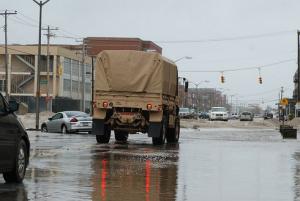FloodsTools to help communities predict, cope with floods
Anticipation and preparedness of large-scale flood events play a key role in mitigating their impacts and optimizing the strategic planning of water resources. Although many countries have well-established systems for river monitoring and early flood warning, an increasing number of inhabitants are affected by floods every year. The Global Flood Awareness System (GloFAS) has been set up providing an overview on upcoming flooding in large world river basins.

National Guard approaching flooded area // Source: commons.wikimedia.com
Anticipation and preparedness of large-scale flood events play a key role in mitigating their impacts and optimizing the strategic planning of water resources. Although many countries have well-established systems for river monitoring and early flood warning, an increasing number of inhabitants are affected by floods every year. The Global Flood Awareness System (GloFAS) has been set up providing an overview on upcoming flooding in large world river basins.
CORDIS reports that on 16-17 January the European Center for Medium-Range Weather Forecasts (ECMWF) hosted a hackathon aimed at improving GloFAS by developing innovative ideas and approaches. More than 3.5 TB of data have been prepared, partly served in an OGC-compliant Web Coverage Service Standard (WCS) for easier data access and retrieval. In the EarthhServer-2 project, this WCS service is currently set up at ECMWF and other institutions in Great Britain. Earthserver-2 is funded under Horizon’s 2020 call H2020-EINFRA-2014-2.
Five teams submitted their work, most of them based on the Big Datacube server rasdaman running at ECMWF, which offers 5-dimensional river discharge data, among others:
- FloodIT: Providing more intuitive information based on GLOFAS which helps forecasting local flooding and pre-empting a catastrophe
- GloFAQ — Global Flood Awareness Queries: Innovative ways of providing end users with key information on potentially impacted infrastructures due to flooding
- Interception: A flood awareness education platform which helps informing people about alternative courses of action when a flood watch/warning alert is issued
- LIVE — Logistic and Infrastructure Visual Evaluation: Using GloFAS forecast information to create a ‘time to respond’ map
- The (flooded) Italian Job: An automatized modification of fixed GloFAS thresholds for warnings
The winning team, LIVE, used GloFAS information creating a “time to respond map” that helps prioritizing decision making before or during a flood event. The second prize went to FloodIT, the third winner was Interception.
CORDIS notes that the GloFAS system is currently used by the International Red Cross in a pilot project in Daares-Salaam, Tanzania for finance forecasting which enables Red Cross to spot early on where flood disaster support is required. The FloodHack price money — in total 1.050 GBP — was donated to this project.
For more information see the DevPost Web site.
